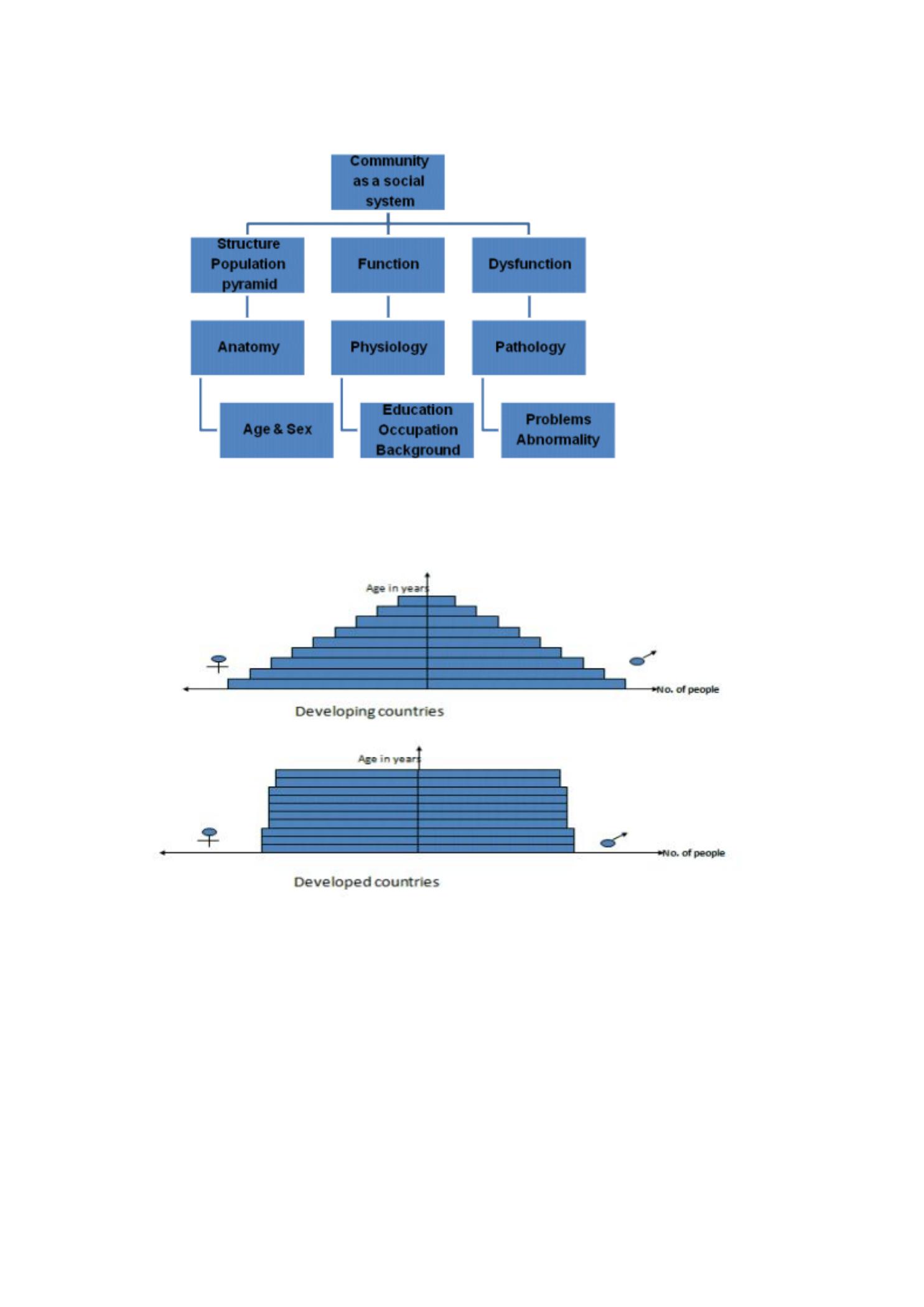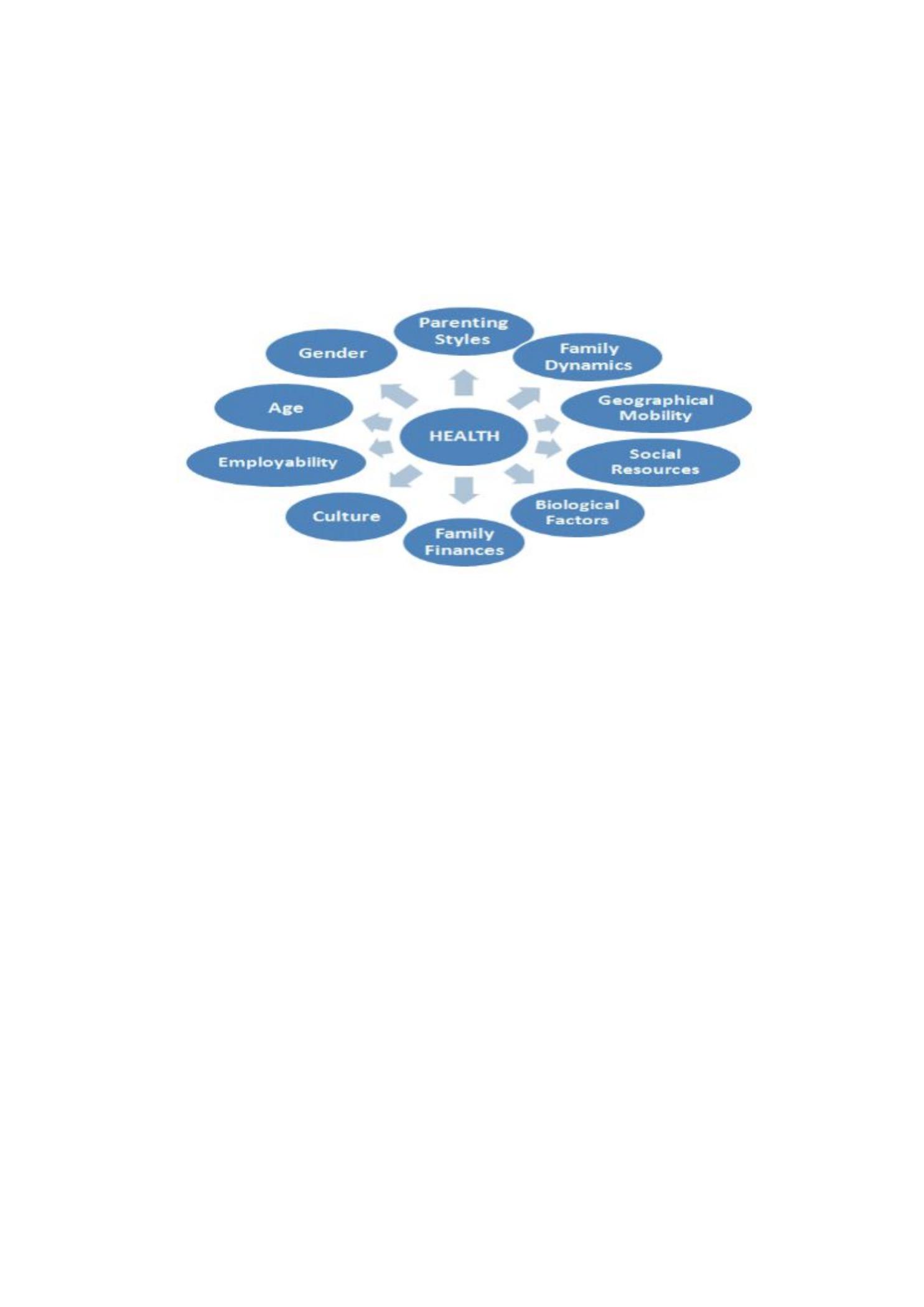
1
College of Medicine –University of Baghdad
Department of Community & Family Medicine
4
th
year Medical Students
First Lecture: Primary Health Care
Overall Aim:
•T
o assist students to understand the concept of Primary Health Care Approach
Sp ecific Ob ject ives:
1.D
efine community medicine, population, health & PHC
2.D
iscuss the types, shapes, uses & importance of population pyramids
3.R
eview the global efforts to improve health & understand the development of
primary health care
4. Define PHC , list the essential principals and elements of PHC
Public health (Community Medicine)
·
Is the art & science of preventing diseases, promoting health & p rolonging
life through the organized efforts of society.
· I
t deals with the health of the whole population.
· L
ooks at the community (population) itself as a patient.
· D
eals with the community as a social system and with the structure, function
& dysfunction of such system.
Population
• Is the smallest social grouping in a country with an effective social structures
& potential administration capacity.
•O
r is a group of people who have things in common & who recognize and
aware of that commonality;
- Geographic communities
- Health center catchment's area, a district, a province, or a country.
- A specific population group
- A specific disease group (with people at risk)
The Figure below showed the structure, functions & dysfunctions of the population

2
What are the differences between the two pyramids?
What is the importance of such population pyramid?
-Health policy planning according to the health needs of the population.
-We’
ll have different diseases in these two kinds of communities; in developing we’
ll
have upper respiratory tract infections, diarrhea, malnutrition & infectious diseases
(immunization). While in developed countries we’
ll have problems of older age
groups obesity, CVA, IHD, CA etc.
Health:
Health is defined as “
a state of complete physical, mental and social wellbeing and not
merely the absence of disease or infirmity”

3
In 1977;
The World Health Assembly adopted the historic resolution on: Health for all by the
year 2000. An acceptable level for health for all people of the world can be attained
through: Fuller and better use of world’
s resources. (A considerable part of which is
now spent on military conflicts)
Factors affecting health
Declaration of the Alma Ata
In 1978 the World Health Organisation (WHO) and the United Nations International
Children’
s Emergency Fund (UNICEF) held a conference on primary health care.
The main outcome of the conference was the Declaration of Alma Ata which has ten
fundamental principles of primary health care.
They are:
•E
quity
•C
ommunity participation
•U
se of socially accepted technology
•H
ealth promotion and disease prevention
•I nvolvement of ALL government departments
•P
olitical action
•C
ooperation between countries
•R
edirection of funding to health
•W
orld peace.
This challenged the world’
s nations to embrace the principles as way of overcoming
health inequality.
Primary Health care approach is defined as:
Is essential health care based on practical, scientifically sound and socially
accep table methods and technologies, made universally accessible to individuals and
families in the community through their full particip ation and at a cost the
community and country can afford to maintain at every stage of their development in
the spirit of self reliance and self determination.

4
The terms primary health care (PHC) and primary care are often used interchangeably.
While primary care may be seen as the first point of care in a community setting, PHC
is the organisation of a full range of health care, from home to hospital, with
prevention as equally important as cure. PHC should be universally available, person
centred and supported by healthy public policies.
Primary Healt h Care is not Primary care alone; it is primary, secondary and
tertiary care.
Primary Health Care is different in each community depending upon:
- Needs of the residents;
- Availability of health care providers;
- The communities geographic location; &
- Proximity to other health care services in the area.
The Basic Requirements for Sound PHC (the 8 A’
s and the 3 C’
s)
• Availability
• Adequacy
• Accessibility
• Acceptability
• Appropriateness
• Affordability
• Assessability
• Accountability
• Completeness
• Comprehensiveness
• Continuity
Essential
Essential Services means that these services or activities are needed and important
for improving the health status of the community & so the community cannot go
without it.
eg. immunization
Availability
• Availability of medical care means that care can be obtained whenever people
need it.
• We must make sure that all areas have health service coverage.
• This means that enough health facilities should be available so that every
member of the community can reach them when needed
Adequacy
• The service proportionate to requirement.
• Sufficient volume of care to meet the need and demand of a community.
Accessibility
• Reachable,
• Convenient services
• Geographic accessibility,
• Economic accessibility,
• Cultural accessibility

5
Acceptability
• Acceptability of care depends on a variety of factors including:
• Satisfactory communication between health care providers and the patients,
• Whether the patients trust this care, and whether the patients believe in the
confidentiality and privacy of information shared with the providers.
Through Health Education, people will understand the benefits of the services.
Appropriateness
• Whether the service is needed at all in relation to essential human needs,
priorities and policies.
• The service has to be properly selected and carried out by trained personnel in
the proper way.
• Health staff should give most of their time & interest to the common disease
which cause most ill-health and deaths in the population rather than
concentrating on few people with rare &’
interesting ’
diseases.
Affordability
• The cost should be within the means and resources of the individual and the
country.
Assessability
• Assessebility means that medical care can be readily evaluated.
Accountability
• Accountability implies the feasibility of regular review of financial records by
certified public accountants..
Completeness
Completeness of care requires adequate attention to all aspects of a medical
problem, including:
• prevention,
• early detection,
• diagnosis,
• treatment,
• follow up measures,
• and rehabilitation.
Comprehensiveness
• Comprehensiveness of care means that care is provided for all types of health
problems.
Continuity
• Continuity of care requires that the management of a patient’
s care over time
be coordinated among providers.
Community Full participation
• The participation of the individuals is vital because they should identify & tell
their own problems.

6
Primary Health Care - Benefits
• PHC focuses on keeping people healthy & addressing illness early so as to
increase probability of cure;
• PHC is client focused;
• Individuals have access to appropriate care;
• Services are matched to community needs;
• Targeted services will have a positive impact on the utilization of health and
social services; &
• Healthy communities with healthy people contribute to a vibrant & stable
economy.
The Main Elements of a PHC Program
1. Health education
2. Promotion of adequate nutrition
3. Immunization against the main infectious diseases
4. Maternal and child health care including family planning
5. Ensuring accessibility to safe and adequate water supply and basic sanitation
6. Control of locally endemic diseases
7. Treatment of common diseases and injuries
8.
Provision of essential drugs
• Other elements can be added, according to the health needs of the community.
Examples are: promotion of mental health, school health services and oral
health services. Whatever the components are, health education is central to
all PHC programs in any community.
• We can see from the above that PHC services are not only promotive and
preventive, but also curative and rehabilitative.
